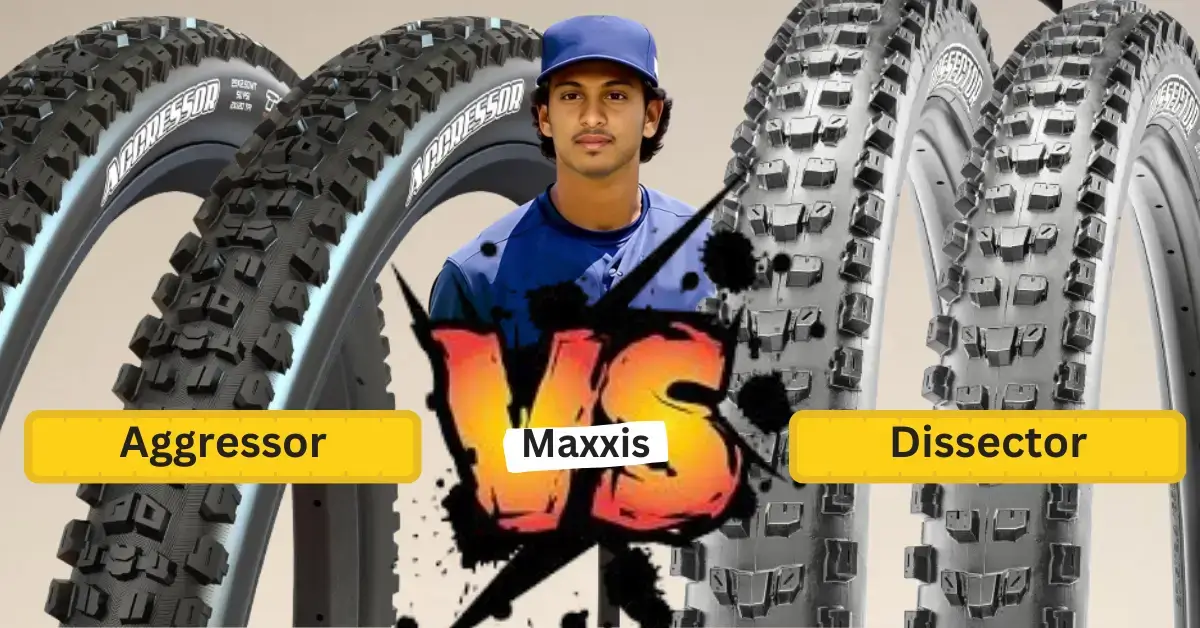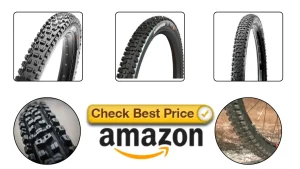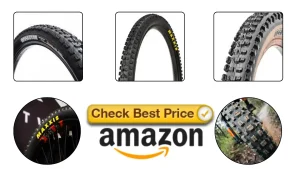When it comes to choosing the right mountain bike tire, it can feel like a tough decision. After months of riding the Maxxis Aggressor and Dissector on technical, dry, and rocky trails, I’ve discovered how they stack up for different MTB riding styles—whether you’re racing downhill, hitting dry terrain, or choosing the right front tire. In this guide, I’ll break down their strengths, weaknesses, and real trail performance—so you can confidently choose the best tire for your terrain and riding goals.
But understanding their differences can help you make the right choice for your riding style. Whether you’re looking for a tire for fast rolling speed, cornering grip, or durability, each tire offers unique benefits. After spending a lot of time on both, I can say that they both excel in different areas. Let’s dive into how each tire performs and which one might be a better fit for you.
Maxxis Aggressor Review
I’ve been using the Maxxis Aggressor as my go-to rear tire for over two years, and it’s never let me down—no matter the trail or terrain.
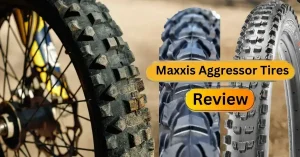
What I Like
After years of riding all kinds of trails, the Maxxis Aggressor has become one of those trusty companions I always come back to. Here’s why I keep choosing it over and over again:
- Grips Like a Champ: The corner knobs are solid. Whether I’m leaning hard into a turn or riding a tight switchback, this tire holds its line like it’s glued to the trail.
- Fast Rolling Center Tread: It doesn’t slow me down on flats or fire roads. I still feel that quick roll, even after long climbs.
- Reliable Braking Traction: When I need to stop on a dime—especially on loose, rocky sections—it doesn’t slip out or make me nervous.
- Durability That Lasts: I’ve been through roots, rocks, and all the rough stuff. It just keeps going without tearing or falling apart.
- Great for Dry Trails: On hardpack or dry singletrack, it’s like magic. The control and flow I get make riding smoother and more fun. During testing on hardpack sections of Sedona’s Mescal Trail and similar loose-over-hard conditions in Moab, the Aggressor felt incredibly predictable and stable.
- Tubeless Ready: Easy setup, fewer flats, and lower pressure for better grip—it checks all the boxes.
- Balanced Feel: It strikes a sweet spot between speed and grip, which is rare. I don’t feel like I’m trading one for the other.
What Could Be Better
Even a great tire isn’t perfect. Here are a few things I noticed that could improve—but honestly, none of them are dealbreakers.
- Not Great in Mud: If you ride wet, sticky trails often, this tire can pack up a bit. It’s not the best at shedding mud, but it’s made for drier trails anyway.
- A Bit Narrow Looking: The 2.3” or 2.35” versions sometimes feel slimmer than expected, especially compared to chunkier tires. Still fits my tight frames well though.
- Double Down Version Is Heavier: The added durability is awesome, but if you’re focused on climbing speed, the extra grams (from the stronger casing) might be noticeable. That said, it’s a worthy tradeoff for the toughness you get.
My Personal Experience
I’ve been using the Maxxis Aggressor for over two years now, on multiple bikes and across a ton of different trails. It’s one of the few tires I’ve actually re-bought multiple times—and that says a lot.
Design
From the first look, I could tell this tire meant business.
The tread pattern is sharp, aggressive, and thoughtfully laid out. It’s got a low-profile center for rolling speed and well-spaced side knobs for grip. What I love is how it doesn’t look flashy—it looks purposeful. It fits snug on the rim, and the overall profile works well with modern trail bikes. It’s that “set-it-and-forget-it” kind of tire in terms of setup and looks.
Performance
This is where it truly shines.
I’ve taken it over roots, rocks, gravel, and hardpack—and it’s never left me second-guessing my grip. Braking is consistent, which makes descending steep stuff way more fun than sketchy. It rolls fast, but not too fast to sacrifice cornering control. Whether I’m chasing PRs or cruising flowy trails, it adapts. The confidence this tire gives me on climbs and descents is a big reason why I keep coming back to it.
Build Quality
Tough, no-nonsense, and trail-proven.
The EXO casing has held up remarkably well—even after months of riding sharp, rocky trails. Sidewalls stay intact, and punctures are rare (thanks to tubeless). The rubber feels durable yet sticky enough to grip. There’s a real sense that Maxxis put thought into making something that lasts without compromising ride feel. Compared to other brands I’ve tried, the Aggressor holds up longer and performs better over time.
Maxxis Dissector Review
I’ve been testing the Maxxis Dissector for over six months on dry and rocky trails. It’s fast, fun, and surprisingly reliable for everyday trail and enduro riding.
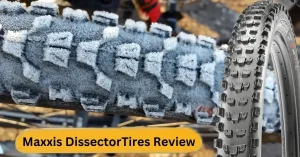
What I Like
I’ve spent months riding with the Maxxis Dissector on the trails, and honestly, there’s a lot to love. Here’s what really stood out for me:
- Fast Rolling, Smooth Climbs
It glides uphill like a dream. The ramped center knobs really reduce drag, making climbs less exhausting and more enjoyable. I’ve noticed I can cover more ground faster without burning out. - Braking Feels Confident
Even though it’s a fast tire, it doesn’t compromise on braking. The rear knobs bite down when you need them to. I’ve hit a few sketchy descents and this tire held up better than I expected. - Great for Dry, Loose Trails
The Dissector grips impressively well on dry trails, especially when used as a front tire. I found it reliable while descending fast lines in dry, dusty conditions—particularly on loose switchbacks. The traction is predictable and lets me lean in with confidence. - Fun Factor: High!
This tire adds a bit of flair to your ride. It’s got just the right amount of drift before hooking up in corners, which feels playful and controlled. It makes trail riding more exciting. - Multiple Casing and Compound Options
Whether you’re into trail, enduro, or downhill, Maxxis has made sure the Dissector has your back. I love that flexibility—it means more riders can dial it in for their style. - Lightweight but Durable
For something that rolls this fast, I was surprised by how durable it’s been. I’ve had zero punctures so far, and I’ve been riding it hard.
What Could Be Better
As much as I enjoy this tire, there are a few areas where it could improve. Nothing deal-breaking, but worth sharing for a full picture.
- Not Ideal as a Front Tire (for Aggressive Riders)
I tried it up front a few times, but the cornering confidence just wasn’t there for me on steeper or technical trails. The edge knobs don’t dig in quite as firmly as a DHF. - Transition Zone Could Be Smoother
There’s a slight delay between the center and side knobs. If you’re used to a tire with a more continuous tread, you might notice that hesitation when leaning into corners. - Edge Knobs Wear Out a Bit Quicker
After months of leaning hard into corners, I noticed a little undercutting on the side knobs. It’s typical for rear tires, but something to keep in mind if you push hard. - Not the Best in Mud
In wet or clay-heavy trails, it tends to pack up. This tire clearly prefers dry, dusty, or sandy terrain, which is fine—just don’t expect it to be a mud warrior.
My Personal Experience
I’ve been riding Maxxis tires for over five years, and the Dissector has been on my rear wheel for the past six months. I ride mostly dry, rocky, and loose-over-hard trails, and I’m constantly looking for that sweet balance between grip, speed, and fun. Learn more about how Maxxis compares to Continental tires in this in-depth review.
Design
The first thing I noticed about the Dissector was its sleek tread pattern. It looks fast even when standing still. The center knobs are lower and tightly spaced, which helps it roll super smooth. Compared to chunkier tires like the DHR II, it feels a lot more agile. That’s a big win when you’re putting in long miles.
The side knobs have that signature Maxxis look, but I wish they were just a touch burlier. Still, they’re solid and add some nice bite when you lean into corners—especially on dry hardpack.
Performance
This tire absolutely flies. If speed is what you’re chasing—especially on smoother trails—it delivers. The lower rolling resistance is noticeable on climbs and flats. I’ve paired it with a DHF up front, and together, they make a perfect trail combo.
Braking traction is better than expected for something this fast, and even on loose descents, I felt planted. It’s playful too—lets you skid a bit before catching, which is honestly a blast when you’re just out having fun.
One time on a steep chute, I expected it to slip out, but it held steady. That moment sold it for me.
Build Quality
Maxxis tires have always impressed me with their build, and the Dissector is no exception. I’ve put in dozens of rides—3 to 4 hours a week—and it’s still holding up strong. No sidewall cuts, no punctures. That’s even with some rocky terrain and aggressive riding.
I’ve noticed a bit of wear on the side knobs, but nothing out of the ordinary for a rear tire under pressure. The casing feels solid, and the tubeless setup was a breeze. For a tire that performs like this, the durability is more than fair.
So, while both tires perform well, it really depends on your terrain and riding goals.
Quick Comparison:
- Dry Trails: Dissector (Front) > Aggressor
- Downhill Grip: Dissector
- Durability: Aggressor
- Fast Rolling: Aggressor (Rear)
- Cornering: Dissector on loose terrain
Maxxis Aggressor vs Dissector: Detailed Comparison
I’ve been testing out both the Maxxis Aggressor and Maxxis Dissector for months now. Whether you’re riding hardpack trails or loose, rocky singletrack, both tires have their strengths. But which one’s better for your ride style? Let’s break it down.
Thread Design & Grip: Maxxis Aggressor vs Dissector
Both tires have solid grip, but their tread patterns cater to different styles. The Aggressor has a faster center tread and solid cornering lugs, ideal for dry, mixed trails. The Dissector has ramped center knobs and squared-off braking edges, which shine in dry and loose conditions.
Features | Maxxis Aggressor | Maxxis Dissector |
Center Tread | Fast rolling, good braking | Ramped for speed, great in loose-over-hard |
Cornering Lug | Strong bite in turn | Better transition, slightly looser edge |
Terrain Suitability | Hardpack, rocky, mixed trails | Loose-over-hard, dry trails |
Rating:
Aggressor: ★★★★★★★★☆☆ (8/10)
Dissector: ★★★★★★★★☆☆ (8/10)
Durability: Maxxis Aggressor vs Dissector
Durability matters when you’re clocking trail hours. The Aggressor holds up better over time, especially on the edge knobs. The Dissector wears faster on the sides if you’re a hard charger.
Features | Maxxis Aggressor | Maxxis Dissector |
Sidewall Wear | Minimal with EXO/DD casing | Faster undercutting of edge knobs |
Center Tread Wear | Long-lasting | Good overall, some wear with time |
Rating:
Aggressor: ★★★★★★★★★☆ (9/10)
Dissector: ★★★★★★★☆☆☆ (7/10)
Size Variation: Maxxis Aggressor vs Dissector
Both tires come in 27.5″ and 29″, but the Dissector wins with more width and casing choices. That gives riders more flexibility.
Features | Maxxis Aggressor | Maxxis Dissector |
Sizes | 26", 27.5", 29" – 2.3 width | 27.5", 29" – 2.4 & 2.6 widths |
Casings | EXO, Double Down | EXO, EXO+, Double Down, DH |
Compounds | Dual Compound | Dual, 3C MaxxTerra, MaxxGrip |
Rating:
Aggressor: ★★★★★★★☆☆☆ (7/10)
Dissector: ★★★★★★★★★☆ (9/10)
Off-Road Performance: Maxxis Aggressor vs Dissector
For rough climbs and tech descents, both hold their own. The Dissector feels faster and more playful. The Aggressor feels more planted and predictable.
Features | Maxxis Aggressor | Maxxis Dissector |
Climbing Grip | Strong, controlled | Fast-rolling, digs in well |
Descending Control | Confident and stable | Playful, quick, slightly looser on the edge |
Rating:
Aggressor: ★★★★★★★★☆☆ (8/10)
Dissector: ★★★★★★★★☆☆ (8/10)
Brand Reputation: Maxxis Aggressor vs Dissector
Maxxis has a solid reputation among MTB riders. Both tires are part of their proven lineup. The Aggressor has a cult following; the Dissector is newer but quickly gaining traction (pun intended).
Features | Maxxis Aggressor | Maxxis Dissector |
Market History | Long-time favorite | Co-designed by a pro rider |
Community Love | Trusted by many | Gaining popularity fast |
Rating:
Aggressor: ★★★★★★★★★☆ (9/10)
Dissector: ★★★★★★★★☆☆ (8/10)
Noise Comfort: Maxxis Aggressor vs Dissector
Neither is silent, but the Aggressor’s tighter center tread makes it a bit quieter. The Dissector’s chunkier design hums a bit more at speed.
Features | Maxxis Aggressor | Maxxis Dissector |
Trail Noise | Lower at high speed | Slightly louder |
Ride Feel | Smoother on hardpack | Louder on pavement |
Rating:
Aggressor: ★★★★★★★★☆☆ (8/10)
Dissector: ★★★★★★★☆☆☆ (7/10)
Technology: Maxxis Aggressor vs Dissector
The Dissector shines here with multiple casing options and MaxxGrip compound. The Aggressor is limited to dual compound, which can feel a bit dated.
Features | Maxxis Aggressor | Maxxis Dissector |
Compound | Dual Compound | Dual, 3C MaxxTerra, MaxxGrip |
Casing Options | EXO, Double Down | EXO, EXO+, Double Down, DH |
Tubeless Ready | Yes | Yes |
Rating:
Aggressor: ★★★★★★★☆☆☆ (7/10)
Dissector: ★★★★★★★★★☆ (9/10)
Temperature Performance: Maxxis Aggressor vs Dissector
Both are best in dry, warm climates. The Dissector doesn’t handle sticky mud well, while the Aggressor also struggles in wet. They’re not made for winter rides.
Features | Maxxis Aggressor | Maxxis Dissector |
Dry Performance | Excellent | Excellent |
Mud Performance | Weak mud clearance | Poor in clay/mud |
Cold Weather Grip | Below average | Below average |
Rating:
Aggressor: ★★★★★★★☆☆☆ (7/10)
Dissector: ★★★★★★★☆☆☆ (7/10)
Longevity & Maintenance: Maxxis Aggressor vs Dissector
The Aggressor wins this round—hands down. Fewer side knob issues and more even wear over time. The Dissector is a bit more high-maintenance if you push hard.
Features | Maxxis Aggressor | Maxxis Dissector |
Maintenance Needs | Low | Medium |
Side Knob Wear | Slower | Undercuts over time |
Tread Longevity | Very good | Good |
Rating:
Aggressor: ★★★★★★★★★☆ (9/10)
Dissector: ★★★★★★★☆☆☆ (7/10)
Cost: Maxxis Aggressor vs Dissector
Pricing is close, but the Aggressor tends to be slightly cheaper. Both are competitively priced in the premium MTB tire market.
Features | Maxxis Aggressor | Maxxis Dissector |
Avg. Price | ~$65 (dual compound) | ~$75+ (3C/DD options) |
Value for Use | High | Good if paired wisely |
Rating:
Aggressor: ★★★★★★★★★☆ (9/10)
Dissector: ★★★★★★★★☆☆ (8/10)
Who Should Choose the Aggressor or Dissector?
If you’re riding dry, rocky trails and need a front tire with confident grip, the Dissector is your go-to. For long rides or rear tire use where durability and speed matter, the Aggressor shines. Downhill riders will love the Dissector’s braking grip, while trail and enduro riders might prefer the Aggressor’s balanced roll.
Conclusion
Both the Maxxis Aggressor and Dissector are great tires, but they shine in different ways. The Aggressor is tough, grips well, and works on many trails. The Dissector rolls fast, feels playful, and corners great in dry conditions. Still not sure which tire fits your ride? Drop a comment below or check out our Best Trail Tires Guide for more insights. And don’t forget—matching your front and rear tires properly can make all the difference! The best tire depends on your trails and how you ride.
FAQs: About Maxxis Aggressor vs Dissector
- What is the Maxxis Aggressor tire best for?
The Maxxis Aggressor is great for fast rolling on hardpack and rocky trails. It works best as a rear tire. It offers strong durability and grip when cornering. - How does the Maxxis Dissector perform on the trail?
The Maxxis Dissector rolls fast and has great cornering. It grips well for braking. It is perfect for dry, loose-over-hard trails. - Is the Maxxis Aggressor better than the Dissector?
It depends on your needs. The Aggressor is durable and good for many terrains. The Dissector is lighter and faster with better cornering on dry trails. - Can the Maxxis Dissector be used as a front tire?
Yes, you can use the Dissector as a front tire. It works well on dry trails, offering good speed and grip. - Are Maxxis tires worth the investment?
Yes, Maxxis tires are known for their strong performance and durability. Both the Aggressor and Dissector offer good value for serious riders. Learn more about their features!
If you want to then you can read our LinkedIn post.
